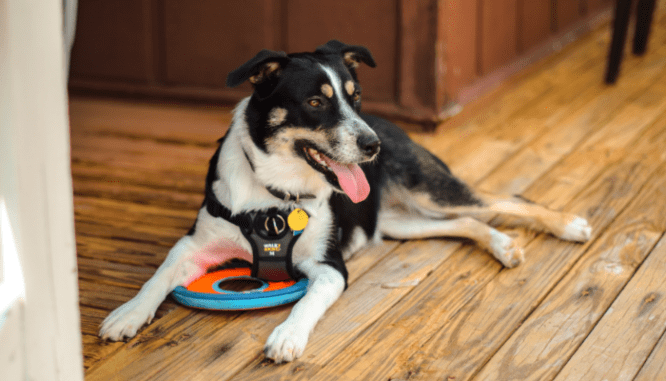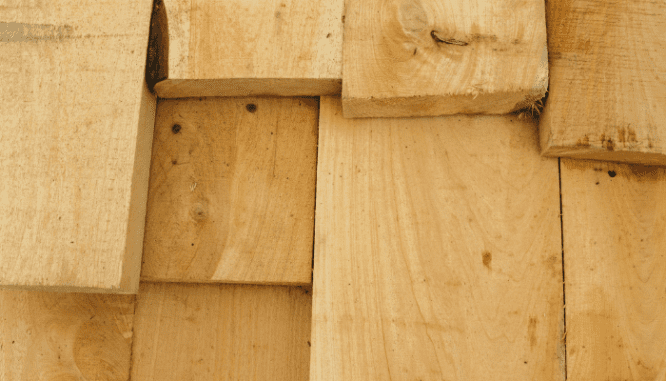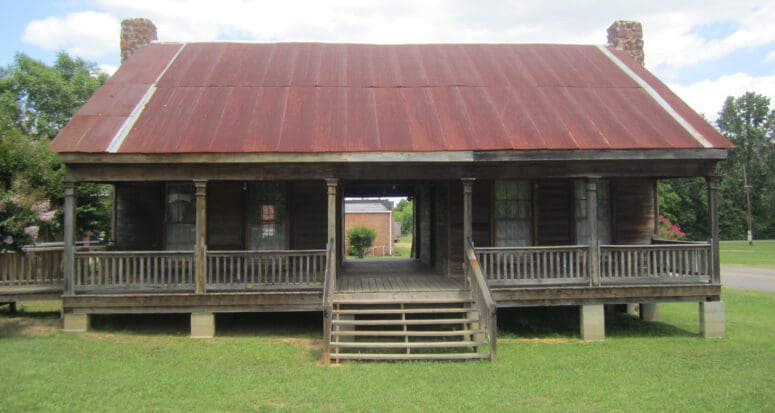What Is a Dogtrot House? An Indoor/Outdoor Concept That’s Withstood the Test of Time
- Published on
- 4 min read
-
 Jen Phillips April Contributing AuthorClose
Jen Phillips April Contributing AuthorClose Jen Phillips April Contributing Author
Jen Phillips April Contributing AuthorJen Phillips April is a freelance writer based in New Orleans, Louisiana. She has more than a decade of experience as a professional writer and has a preservation background. She bought one historic home in Philadelphia's Fishtown neighborhood and has worked in multiple historic home museums in New Orleans and Philadelphia.
Imagine living in a rustic home that invites the outdoors in. One where you can enjoy the cool evening breezes gliding through your home and sip your morning coffee overlooking your back porch. That’s the lifestyle of the dogtrot house.
The name dates back to some of the earliest residences in the country and references the heat of the day when it’s so hot, the dogs seek a shady spot for an afternoon nap. Primarily found across the Deep South from Appalachia to the Carolinas to Texas, the dogtrot design maximized air circulation in the days before air conditioning.
We turned to the experts to find out what, exactly, a dogtrot house is. We take a look at its history, its characteristics, and how architects and builders have adapted the style to today’s aesthetic to bring form and function to modern families.

What is a dogtrot house?
The exact origins of the dogtrot house are unclear. Some say the design originated in the Appalachian Mountains of Tennessee and Kentucky, while others say it came from the coastal areas of the Carolinas. No matter where they originated, it’s clear this style was born of necessity, and it’s found across the South.
The dogtrot home is also known as a dog-run, possum-trot, and breezeway home. Early structures traditionally comprise two log cabins built close together with a breezeway between the buildings and covered by the same roof. It’s a functional design meant to take advantage of cross breezes and offer a shady spot away from the midday sun.
Like all vernacular architecture, the South’s steamy climate made the dogtrot style practical since it encourages airflow and shady areas. Some of these homes exist as museums today, like the Autrey House Museum in Dubach, Louisiana.
Built by Absalom Autrey in 1849, the log house is thought to be the oldest building in Lincoln Parish and is listed on the National Register of Historic Places. Like many of the early dogtrot homes, the Autrey House Museum has two individual log cabins known as “pens.” There’s a passageway between the two pens and one roof covering the entire structure. Autrey lived there with his wife, Elizabeth Norris, and their 14 children.

Characteristics of a dogtrot house
The primary characteristic of the dogtrot house is the open breezeway between two separate living areas. Connected by one roof, the living/kitchen area is often on one side, with the bedrooms on the other. However, historically, it wasn’t unusual for the kitchen to be in a separate building away from the house. That offered a measure of safety in case of a kitchen fire.
With windows on all sides, the dogtrot house can be light and airy. The windows let in plenty of sunlight, enhance cross breezes, and reduce mold growth.
While most dogtrot houses are one story, sometimes there’s a partial second-floor attic or bedroom accessible by stair or ladder.
Chimneys on either side of the house provided heat and light on cold winter evenings. These days, they give symmetry to the roof and offer ambiance.
The design catches breezes and maximizes ventilation in warm climates. Many dogtrot homes have the long axis run east to west to reduce solar gain, perhaps better known as reducing sun exposure.
Typically one story, these homes likely had tin roofs and dirt floors in the late 19th century, but these days, developers are offering an updated version.
“The dogtrot homes we do are almost always preservations of log or stone structures that have been in Texas families for 150 years or more,” says architect Steve Chambers of Stephen B. Chambers Architects, Inc. in Dallas, Texas.
“The inconvenience of an open-air passageway between two parts of the house is a small inconvenience for the honor of being able to live in an ancestor’s historic home — to feel their presence and understand how they managed in more primitive conditions.”
According to Chambers, “The early settlers learned that when two structures were positioned near each other, the movement of air between them was intensified by the Venturi effect. These partitioned homes got their name from the fact that dogs took advantage of a covered porch and cool breezes to find comfort in the long days of summer.”
The Venturi effect is a physics term that describes a ventilation technique that encourages air flow through and around the buildings.
Many of the early dogtrot homes have verandas that span the front and back of the house, giving additional access to breezes and shade. In the days before air conditioning, people used their verandas for resting, visiting, and some meal prep, such as shelling peas.
In their earliest incarnation as log cabins, the dogtrot would have been on the ground. But over the years, as people were able to rebuild or upgrade their homes, they also raised them off the ground to enhance air circulation and reduce the risk of flooding during coastal area storms.

Construction of dogtrot houses
Originally dogtrot houses were two log cabins side-by-side and joined together under one roof. Sometimes called “pens,” one was used as a living room and the other as a bedroom. There would also be a fireplace at each end offered heating — and if the kitchen was under the same room — cooking options.
Some built the kitchen separately and connected them by a covered walkway. A separate kitchen cut down on the heat in the home and reduced the risk of kitchen fires that could endanger the rest of the home.
By the late 19th century, factory-produced lumber and nails provided accessible materials for framing and wood siding. The homes’ location dictated the types of materials used as local building materials tend to be more suitable to the climate and most accessible.
For example, in the Southern lowlands, such as near the rice fields of Charleston, South Carolina, cypress was often used for exterior siding and wood shake roofs. Cypress trees are native to swamplands, so they’re mold/rot resistant. You’ll see floors made of longleaf pine and bricks of local clay. Knowledgeable builders can use the clay’s color to identify its origin. Today, the wood is treated for water and termite resistance.

Dogtrot houses in today’s world
The indoor/outdoor design is appealing for modern-day living. “There are some modern variations on the dogtrot theme, where sections of the home are divided by sliding glass doors or screen porches. Whatever the choice, people do enjoy the breezes that fill these open areas,” Chambers says.
The modern dogtrot often expands on the historic floor plan. Rather than two rooms (or four smaller rooms) with a breezeway in the middle, architects opt for more (and larger) rooms, and the breezeway doesn’t have to be center. It can even be enclosed.
In this example from Stephen B. Chambers, Inc., two 1860 pens serve as sleeping areas with living space in between. “This is a new home which my firm designed that has dogtrot features,” Chambers says. “It works great for the site and what the client wanted in terms of a home with features reminiscent of Texas structures a hundred years ago or more.”
This rustic aesthetic is typical of the newer dogtrot-inspired homes and many modern versions have high ceilings and spacious rooms with large windows that offer a view. When entertaining, guests can easily move between rooms, and the open breezeway can serve as an inspiration for an outdoor entertaining area.
Many of today’s homes have wide doors on either end of the breezeway that open to let the air in. Such doors give the homeowner options. For example, they can choose to fold back the doors on either side of the breezeway in nice weather and enjoy the natural breeze. Or, they can close it off and use the central heat and air conditioning as they wish.
Interior Designer Lauren Schroeder of Live Oak Design and Development based in Bluffton, South Carolina, says, “Recent design trends are moving to a focus on the indoor/outdoor living concept.” She says people are seeing the value of walking through the front door and seeing right into the spacious back porch or patio.
“While entertaining, you can stand in your kitchen and enjoy your company or family outside on the porch and never miss a beat,” she notes.
She says there are many great new products on the market to support this indoor/outdoor lifestyle. “From large pass-through windows to wall-to-wall glass doors where the panels fold back on each other and feel like they completely disappear, and now the great room is part of the outdoor space. It has become the way of life in a lot of areas and is highly sought after.”
She mentions another benefit of the indoor/outdoor concept, which is the feeling of spaciousness even in a smaller space. “The indoor/outdoor concept allows one to build a smaller square footage home while giving the feel of a larger square footage home, and with rising construction costs, that is very desirable.”
If there are any drawbacks to the dogtrot home style, it really boils down to personal preference and the condition the home is in. If you’re considering buying an older dogtrot home, the same considerations apply to all older homes. Is the foundation stable? What updates may be needed either structurally or aesthetically? A reputable agent can help guide you through the process of choosing the right home for you.
Header Image Source (re-sized): (Billy Hathorn / Wikimedia Commons via Creative Commons Legal Code)
